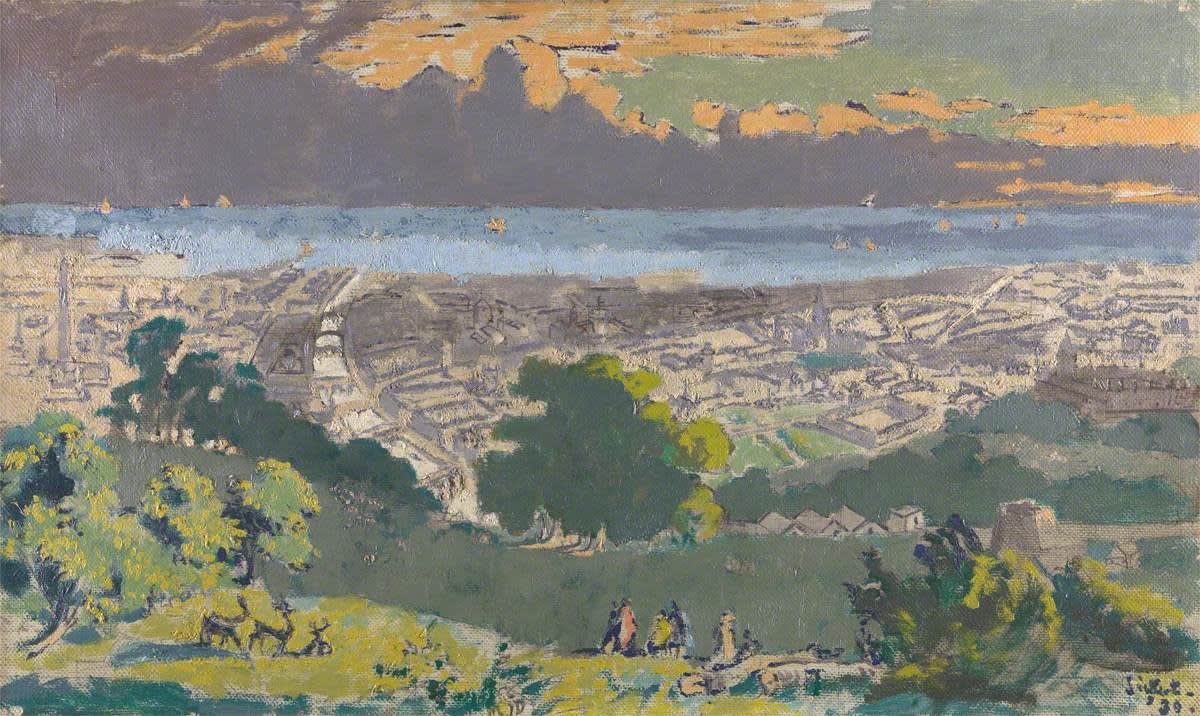Walter Richard Sickert 1860-1942
Dublin Bay from Phoenix Park, 1930
Oil on Canvas
42 x 73 cms
16 8/16 x 28 11/16 ins
16 8/16 x 28 11/16 ins
261
Sold
In the late 1920s Sickert embarked on a series of paintings, entitled English Echoes in which he drew attention to popular nineteenth century illustration. Taking a black and white print...
In the late 1920s Sickert embarked on a series of paintings, entitled English Echoes in which he drew attention to popular nineteenth century illustration. Taking a black and white print as his starting point, each painting is, on one level, an imaginative exercise in colour. But the nature of these English sources was also a means by which Sickert could place himself, an immigrant to Britain, in a line of British art, and a method by which he could elevate the status of a previously neglected popular art form. In this way Sickert asserted the power of British figurative art in the face of International claims for abstraction and surrealism.
In May 1931 the Leicester Galleries held the very first exhibition of these English Echoes, in which they included Dublin Bay from Phoenix Park. Its source was a landscape by Francesco Sargent, an artist, who Sickert explained in the catalogue `treated contemporary history, landscape, marine subjects and architecture with equal brilliance.'
Richard Morphet in the catalogue for the exhibition Late Sickert at the Hayward Gallery in 1981 writes of the importance of `Sickert's role in editing and selectively intensifying his source' in his Echoes: `Here he can be seen variously picking out particular details for sharper examination or unifying the pictorial scheme into a more continuous, all-over surface than its nineteenth century engraved source. They seem quite extraordinarily able to convey the flavour and certain types of situation of their original time and place.. The Echoes make us aware of a preoccupation running through his late work with the mystery of time, the enigmatic relationship between `then' and `now'. Both the colour and many of the subjects of the Echoes have a hedonistic character in marked contrast to the disturbing side of Sickert's vision.'
Helen Lessore, whose first essay on the artist, published in 1932, was devoted to these paintings, has also drawn attention to `the consistent treatment of the canvas as a surface, with an all-over equality of tension between the flat shapes into which it is divided, irrespective of what they represent. There is a Firbankian quality in Sickert's Echoes, in that the entire surface is an exquisite, shimmering decoration.' Helen Lessore, `Sickert's late work', 1981.
These Echoes were immediately popular. The Louvre bought one in 1932 (now in the Musée d'Art Moderne in Paris) and Echoes formed the basis of a series of successful exhibitions of Sickert held by the Leicester Galleries and Beaux Arts Galleries in the 1930s.
In May 1931 the Leicester Galleries held the very first exhibition of these English Echoes, in which they included Dublin Bay from Phoenix Park. Its source was a landscape by Francesco Sargent, an artist, who Sickert explained in the catalogue `treated contemporary history, landscape, marine subjects and architecture with equal brilliance.'
Richard Morphet in the catalogue for the exhibition Late Sickert at the Hayward Gallery in 1981 writes of the importance of `Sickert's role in editing and selectively intensifying his source' in his Echoes: `Here he can be seen variously picking out particular details for sharper examination or unifying the pictorial scheme into a more continuous, all-over surface than its nineteenth century engraved source. They seem quite extraordinarily able to convey the flavour and certain types of situation of their original time and place.. The Echoes make us aware of a preoccupation running through his late work with the mystery of time, the enigmatic relationship between `then' and `now'. Both the colour and many of the subjects of the Echoes have a hedonistic character in marked contrast to the disturbing side of Sickert's vision.'
Helen Lessore, whose first essay on the artist, published in 1932, was devoted to these paintings, has also drawn attention to `the consistent treatment of the canvas as a surface, with an all-over equality of tension between the flat shapes into which it is divided, irrespective of what they represent. There is a Firbankian quality in Sickert's Echoes, in that the entire surface is an exquisite, shimmering decoration.' Helen Lessore, `Sickert's late work', 1981.
These Echoes were immediately popular. The Louvre bought one in 1932 (now in the Musée d'Art Moderne in Paris) and Echoes formed the basis of a series of successful exhibitions of Sickert held by the Leicester Galleries and Beaux Arts Galleries in the 1930s.
Provenance
Leicester Galleries, LondonPrivate Collection, Bradford
Exhibitions
Sickert English Echoes, Leicester Galleries, London, May 1931, no.27.Sickert, National Gallery, London, 1941, no.81.
Literature
Apollo, 13 June 1931, p.347.Wendy Baron, Sickert, London 1973, (no. 433), pp.178, 386.
Twentieth-century British Art, James Hyman Gallery, London, 2001, (cat. 5), illustrated p.13.




